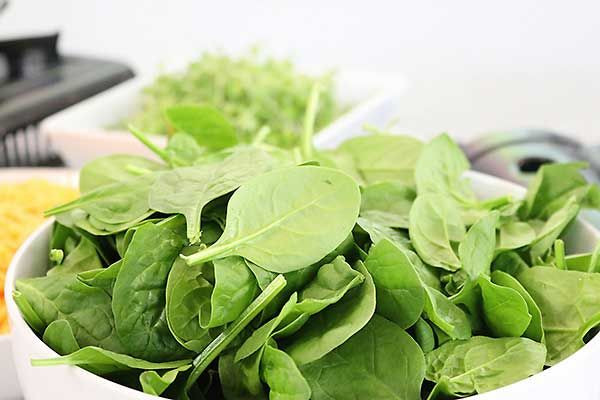Cut Leafy Greens
Also available as a PDF in English, Spanish, Simplified Chinese, Traditional Chinese, Korean
What Food Establishments Should Know
In recent years there have been foodborne illness outbreaks and product recalls associated with cut leafy greens contaminated with pathogens.
The Illinois Food Code designates cut leafy greens as a “time/temperature control for safety food” (TCS), formerly known as potentially hazardous food, that must be maintained at temperatures of 41°F or below. “Cut leafy greens” means fresh leafy greens whose leaves have been cut, shredded, sliced, chopped or torn.
Examples of leafy greens:
- Arugula
- Cabbage
- Chard
- Endive
- Escarole
- Iceberg, romaine, butter, leaf, and baby leaf lettuce
- Kale
- Spinach
- Spring mix

This applies to commercially processed cut leafy greens, such as bagged salad mixes and spinach, and to leafy greens that have been cut at the food establishment. Cut leafy greens do not include herbs, such as cilantro or parsley.
It does not include whole heads of lettuce or other raw agricultural commodities. “Cut” does not include removing and discarding exterior leaves and/or simply washing the leafy greens, which is a common practice for display in grocery stores. However, if the leaves are further cut, shredded, sliced, chopped or torn, then the product would be considered a cut leafy green and therefore are TCS.
To verify proper cold holding of cut leafy greens, measure the product temperature with a thin probe thermometer by inserting the tip in the thicker stem portion of the leaf. For sealed bags of product, insert a thermometer probe between bagged products or fold the bag tightly around the probe to ensure adequate contact with the product.
Public Health Reasons
Cut leafy greens were designated as a TCS because they provide a medium that readily supports the growth of pathogens when they are held without temperature control. Cutting or shredding alters the physical properties of the leaf and provides opportunities for microbial growth.
Contamination of leafy greens with pathogens can occur in the field, processing facilities, transport vehicles, or food establishments. Regardless of where or how the contamination occurs, proper mechanical refrigeration will limit the growth of pathogens that may be present on cut leafy greens.
What Farmers’ Market Vendors Should Know
In recent years there have been foodborne illness outbreaks and product recalls associated with cut leafy greens contaminated with pathogens.
The Illinois Food Code designates cut leafy greens as a “time/temperature control for safety food” (TCS), formerly known as potentially hazardous food, that must be maintained at temperatures of 41°F or below. “Cut leafy greens” means fresh leafy greens whose leaves have been cut, shredded, sliced, chopped or torn.
Examples of leafy greens include arugula, cabbage, chard, endive, escarole, and iceberg, romaine, butter, leaf and baby leaf lettuce, kale, spinach and spring mix.
This applies to commercially processed cut leafy greens, such as bagged salad mixes and spinach, and to leafy greens that have been cut at a food establishment. Cut leafy greens do not include herbs, such as cilantro or parsley.
Harvesting leafy greens by cutting from their root in the field (this is sometimes called a “field or harvest cut”) with no additional cutting, shredding, slicing, chopping or tearing are not considered cut leafy greens, but a raw agricultural commodity.
- Leafy greens that have the stem, stalk or the butt of the core trimmed are not considered cut leafy greens.
- Leafy greens simply washed (to remove field soil) are not considered cut leafy greens.
- If the core of a head of lettuce or cabbage is removed, remaining leaves are considered cut leafy greens.
- Leafy greens with leaves that have been cut, shredded, sliced, chopped or torn are considered cut leafy greens.
- What this means for farmers bringing items to the market:
- Greens cut from their root in the field (harvest cut) and brought directly to the market are not considered cut leafy greens. No temperature control required.
- Kale, chard, spinach and other greens that are cut from the root in the field and bundled for sale are not considered cut leafy greens. No temperature control required.
- Cut leafy greens at farmers’ markets, including salad or leafy green mixes where the leaves are cut, sliced, chopped or torn – like Caesar greens (cut romaine) – require time-temperature control and a health permit.
- If your operation is selling an item that is considered a cut leafy green that will require time or temperature control, you will need to obtain a health permit to sell the items at a farmers’ market. If you fall under this category, please visit www.c-uphpd.org or call one of the phone numbers listed below.
HOURS AND CONTACT INFORMATION
Monday - Friday 8:00 a.m. - 4:00 p.m.
Phone: 217-373-7900 or 217-363-3269
Email:
201 W. Kenyon Rd., Champaign, IL 61820
